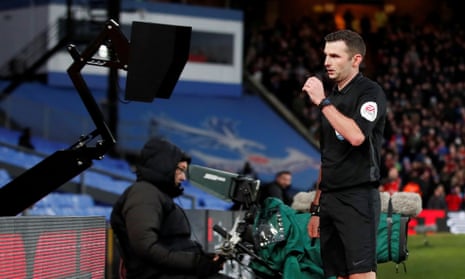After months standing idle at the side of Premier League pitches, VAR monitors look set to be called into action this weekend after referees were finally encouraged to use them.
The refereeing body the PGMOL this week spoke to Premier League referees and suggested they should in most circumstances consult their pitchside screens if VAR recommends a referee upgrade a yellow card to a red or change a sending-off to a booking.
Referees will be encouraged to check the monitor should the VAR recommend a change in cases of serious foul play or violent conduct. Red cards for the denial of a goalscoring opportunity, however, will still be decided by the VAR, as they are thought best placed to make a final call on whether the player judged to have made the foul was the last man.
Officials believe the latest ruling is merely a restatement of PGMOL’s original policy, which allowed referees to consult their monitors when they had been deprived of crucial information, such as being unable to see an incident. The practice has been for referees to ignore screens.
To date a monitor has been used only once this season and that was during an FA Cup tie between Crystal Palace and Derby. In that match, the referee Michael Oliver opted to give Palace midfielder Luka Milivojevic a yellow card following an altercation with a Derby player. After an intervention by VAR, however, Oliver chose to look at the incident again and upgraded the card from yellow to red.
Jürgen Klopp gave his backing to the change. “The only reason for having it is to use it,” the Liverpool manager said. “I don’t know why they aren’t used so far. We want the right decisions so we should use all sources. It won’t happen five or six times a game. It’s just about 100% clarification that is needed.”
Although there has been nothing explicitly preventing referees from consulting their monitors, their use has not been encouraged. This is largely owing to the extra delay it would cause. PGMOL officials calculated there was a delay of 90 seconds every time a monitor was used, a red flag for an organisation which defined any delay of that length as ‘significant’.
Following a series of controversial and hairline decisions by VAR, however, there has been a clamour for monitors to be used. This appears to have been heeded by the authorities. Whether it puts an end to questions over the use of monitors remains moot, with other instances, such as the application of the handball law in penalty situations, having proven controversial.
The League Managers Association has written to football’s lawmakers to raise concerns over the handball rule before the International Football Association Board’s AGM next month.
